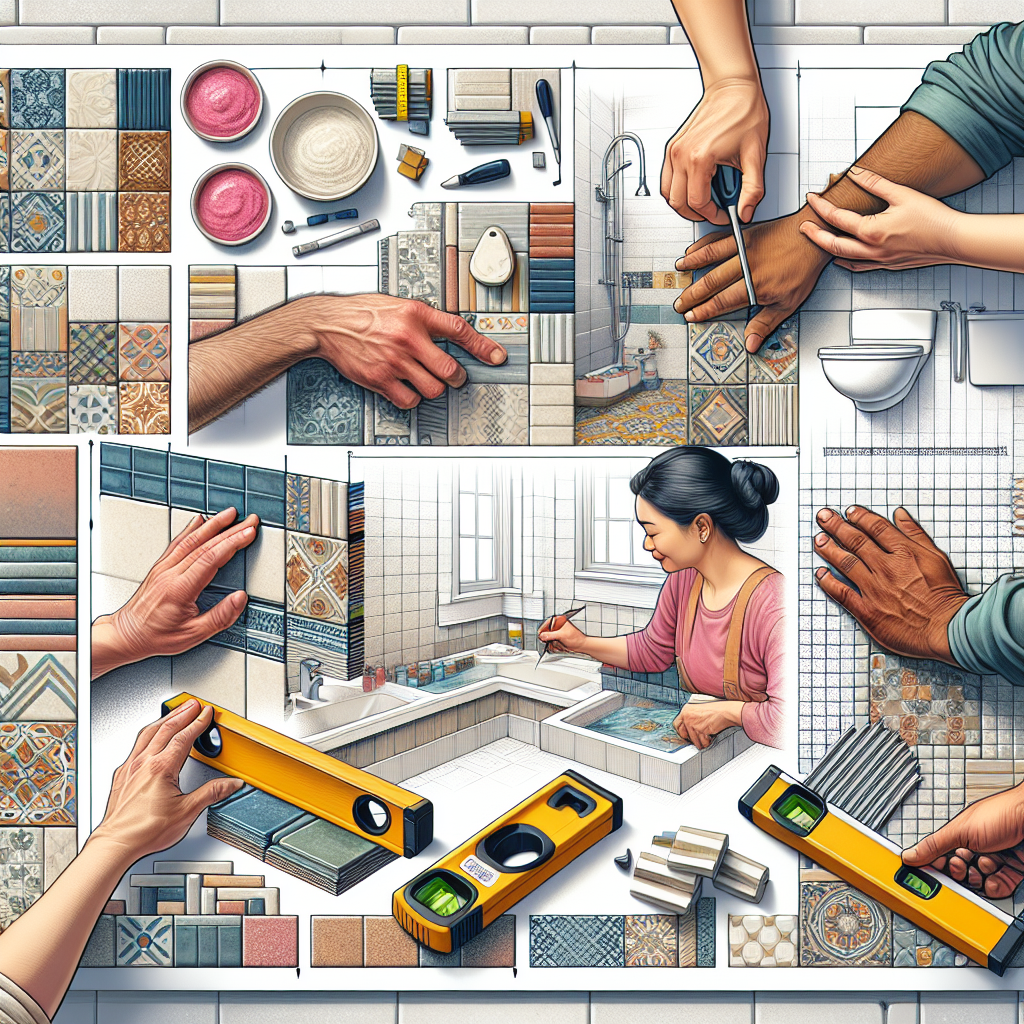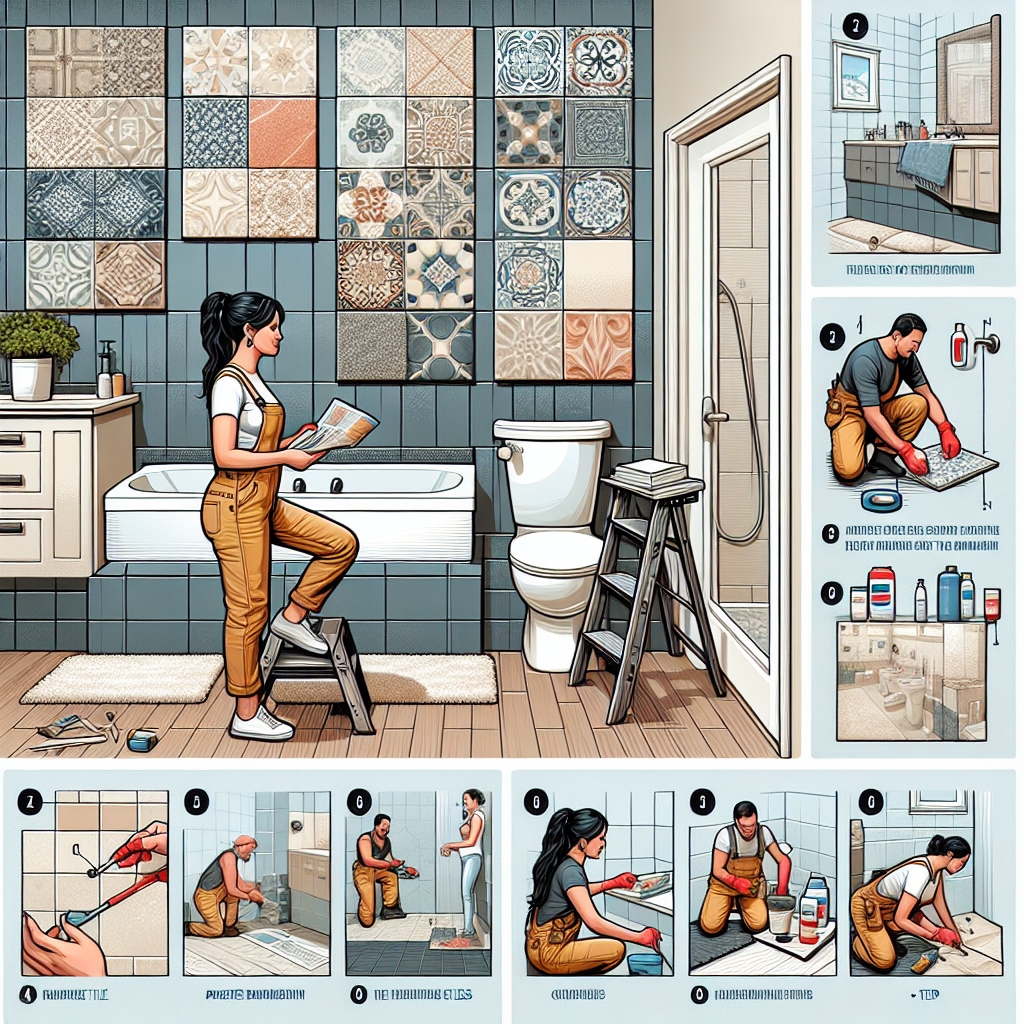Best Practices for DIY Bathroom Tile Selection and Installation

When it comes to renovating a bathroom, one of the most important decisions you’ll make is selecting and installing the right tiles. The right tiles can transform your bathroom into a stylish and functional space, while the wrong ones can lead to costly mistakes and headaches. In this article, we will explore the best practices for DIY bathroom tile selection and installation, providing valuable insights and tips to help you achieve a successful outcome.
1. Understanding Your Needs and Budget
Before diving into the world of bathroom tiles, it’s crucial to understand your needs and budget. Consider the following factors:
- Functionality: Determine the level of durability and water resistance required for your bathroom. For example, if you have a high-traffic bathroom or a family with young children, you may need tiles that are more resistant to wear and tear.
- Style: Think about the overall style and aesthetic you want to achieve. Are you going for a modern, minimalist look or a more traditional and ornate design? Consider the color scheme, patterns, and textures that will complement your vision.
- Budget: Set a realistic budget for your tile selection and installation. Keep in mind that the cost of tiles can vary significantly depending on the material, size, and brand.
By understanding your needs and budget upfront, you can narrow down your options and make informed decisions throughout the selection and installation process.
2. Researching Tile Materials
There are various tile materials available in the market, each with its own unique characteristics and benefits. Here are some popular options:
- Ceramic Tiles: Ceramic tiles are a popular choice for bathrooms due to their affordability, versatility, and ease of maintenance. They come in a wide range of colors, patterns, and sizes.
- Porcelain Tiles: Porcelain tiles are known for their durability and water resistance. They are an excellent choice for bathrooms that experience heavy foot traffic or are prone to moisture.
- Natural Stone Tiles: Natural stone tiles, such as marble, granite, and travertine, add a touch of luxury and elegance to any bathroom. However, they require more maintenance and can be more expensive.
- Glass Tiles: Glass tiles are a popular choice for creating a modern and sleek look. They are available in various colors and finishes, allowing for creative design possibilities.
Researching different tile materials will help you understand their pros and cons, allowing you to make an informed decision based on your needs, budget, and desired aesthetic.
3. Considering Tile Size and Layout
The size and layout of your tiles can greatly impact the overall look and feel of your bathroom. Here are some considerations:
- Tile Size: Larger tiles can create a sense of spaciousness and make a small bathroom appear larger. However, smaller tiles can offer more design flexibility and allow for intricate patterns.
- Grout Lines: The width of the grout lines can affect the visual impact of your tiles. Thinner grout lines can create a seamless and modern look, while wider grout lines can add texture and emphasize the individual tiles.
- Layout: Consider the layout and orientation of your tiles. For example, a herringbone pattern can add visual interest and sophistication, while a simple grid pattern can create a clean and timeless look.
Take the time to experiment with different tile sizes and layouts to find the perfect combination that suits your bathroom’s style and dimensions.
4. Preparing the Surface and Ensuring Proper Installation
Proper surface preparation and installation are crucial for the longevity and performance of your bathroom tiles. Follow these steps:
- Clean and Level the Surface: Ensure that the surface is clean, dry, and free from any debris or unevenness. Use a leveling compound if necessary to create a smooth and even base.
- Use High-Quality Adhesive: Invest in a high-quality adhesive that is suitable for your chosen tile material. Follow the manufacturer’s instructions for mixing and applying the adhesive.
- Apply Tiles with Precision: Take your time to lay the tiles with precision, ensuring even spacing and alignment. Use tile spacers to maintain consistent gaps between tiles.
- Grout and Seal: Once the tiles are set, apply grout to fill the gaps between them. Choose a grout color that complements your tiles. After the grout has dried, apply a sealant to protect the tiles from moisture and stains.
Following these steps will help ensure a professional-looking installation and minimize the risk of future issues such as loose tiles or water damage.
5. Maintaining and Cleaning Your Tiles
Proper maintenance and cleaning are essential for keeping your bathroom tiles looking their best. Here are some tips:
- Regular Cleaning: Clean your tiles regularly using a mild detergent and a soft cloth or mop. Avoid abrasive cleaners that can damage the tiles.
- Preventing Stains: Wipe up any spills or stains immediately to prevent them from seeping into the grout or tiles. Use a grout sealer to protect the grout from stains and discoloration.
- Avoid Harsh Chemicals: Avoid using harsh chemicals or acidic cleaners that can damage the tiles or grout. Instead, opt for natural cleaning solutions or products specifically designed for tile maintenance.
By following these maintenance practices, you can extend the lifespan of your bathroom tiles and keep them looking beautiful for years to come.
Frequently Asked Questions about “Best Practices for DIY Bathroom Tile Selection and Installation”
1. What are the most durable tile materials for a bathroom?
The most durable tile materials for a bathroom are porcelain and natural stone. Porcelain tiles are highly resistant to water, stains, and wear, making them ideal for high-traffic bathrooms. Natural stone tiles, such as granite and marble, are also durable but require more maintenance to prevent staining and etching.
2. How do I choose the right grout color for my tiles?
When choosing a grout color, consider whether you want the grout lines to blend in or stand out. A grout color that matches the tiles will create a seamless look, while a contrasting color can add visual interest. It’s also important to consider the maintenance aspect, as lighter grout colors may require more frequent cleaning to keep them looking fresh.
3. Can I install tiles over existing tiles in my bathroom?
Yes, it is possible to install new tiles over existing tiles in your bathroom. However, it’s important to ensure that the existing tiles are in good condition, firmly adhered to the surface, and free from any cracks or damage. Additionally, keep in mind that adding another layer of tiles will increase the height of the floor, which may require adjustments to doors and fixtures.
4. How do I prevent mold and mildew in my bathroom tiles?
To prevent mold and mildew in your bathroom tiles, ensure proper ventilation by using exhaust fans or opening windows during and after showers. Regularly clean and dry the tiles, paying special attention to the grout lines where mold and mildew tend to grow. Consider using mold-resistant grout and sealants to provide an extra layer of protection.
5. What should I do if I encounter a problem during the tile installation process?
If you encounter a problem during the tile installation process, it’s best to address it promptly to avoid further complications. Consult online resources, tutorials, or seek advice from professionals to troubleshoot the issue. In some cases, it may be necessary to seek professional help to ensure a successful outcome.
Summary
Selecting and installing bathroom tiles can be a challenging task, but by following best practices, you can achieve a successful DIY project. Start by understanding your needs and budget, researching different tile materials, and considering tile size and layout. Proper surface preparation and installation are crucial for long-term durability, and regular maintenance will keep your tiles looking their best. By following these best practices, you can create a beautiful and functional bathroom that will stand the test of time.

